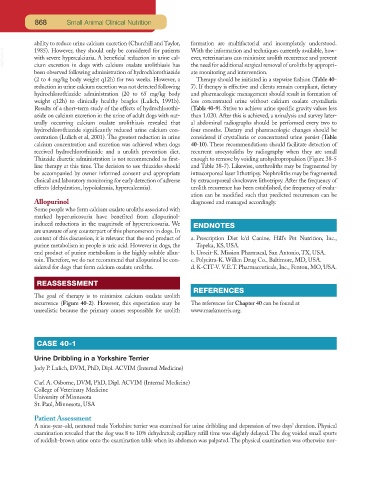Page 837 - Small Animal Clinical Nutrition 5th Edition
P. 837
868 Small Animal Clinical Nutrition
ability to reduce urine calcium excretion (Churchill and Taylor, formation are multifactorial and incompletely understood.
VetBooks.ir 1985). However, they should only be considered for patients With the information and techniques currently available, how-
ever, veterinarians can minimize urolith recurrence and prevent
with severe hypercalciuria. A beneficial reduction in urine cal-
the need for additional surgical removal of uroliths by appropri-
cium excretion in dogs with calcium oxalate urolithiasis has
been observed following administration of hydrochlorothiazide ate monitoring and intervention.
(2 to 4 mg/kg body weight q12h) for two weeks. However, a Therapy should be initiated in a stepwise fashion (Table 40-
reduction in urine calcium excretion was not detected following 7). If therapy is effective and clients remain compliant, dietary
hydrochlorothiazide administration (20 to 65 mg/kg body and pharmacologic management should result in formation of
weight q12h) to clinically healthy beagles (Lulich, 1991b). less concentrated urine without calcium oxalate crystalluria
Results of a short-term study of the effects of hydrochlorothi- (Table 40-9). Strive to achieve urine specific gravity values less
azide on calcium excretion in the urine of adult dogs with nat- than 1.020. After this is achieved, a urinalysis and survey later-
urally occurring calcium oxalate urolithiasis revealed that al abdominal radiographs should be performed every two to
hydrochlorothiazide significantly reduced urine calcium con- four months. Dietary and pharmacologic changes should be
centration (Lulich et al, 2001). The greatest reduction in urine considered if crystalluria or concentrated urine persist (Table
calcium concentration and excretion was achieved when dogs 40-10). These recommendations should facilitate detection of
received hydrochlorothiazide and a urolith prevention diet. recurrent urocystoliths by radiography when they are small
Thiazide diuretic administration is not recommended as first- enough to remove by voiding urohydropropulsion (Figure 38-5
line therapy at this time. The decision to use thiazides should and Table 38-7). Likewise, urethroliths may be fragmented by
be accompanied by owner informed consent and appropriate intracorporeal laser lithotripsy. Nephroliths may be fragmented
clinical and laboratory monitoring for early detection of adverse by extracorporeal shockwave lithotripsy. After the frequency of
effects (dehydration, hypokalemia, hypercalcemia). urolith recurrence has been established, the frequency of evalu-
ation can be modified such that predicted recurrences can be
Allopurinol diagnosed and managed accordingly.
Some people who form calcium oxalate uroliths associated with
marked hyperuricosuria have benefited from allopurinol-
induced reductions in the magnitude of hyperuricosuria. We ENDNOTES
are unaware of any counterpart of this phenomenon in dogs. In
context of this discussion, it is relevant that the end product of a. Prescription Diet k/d Canine. Hill’s Pet Nutrition, Inc.,
purine metabolism in people is uric acid. However in dogs, the Topeka, KS, USA.
end product of purine metabolism is the highly soluble allan- b. Urocit-K. Mission Pharmacal, San Antonio, TX, USA.
toin.Therefore, we do not recommend that allopurinol be con- c. Polycitra-K. Willen Drug Co., Baltimore, MD, USA.
sidered for dogs that form calcium oxalate uroliths. d. K-CIT-V. V.E.T. Pharmaceuticals, Inc., Fenton, MO, USA.
REASSESSMENT
REFERENCES
The goal of therapy is to minimize calcium oxalate urolith
recurrence (Figure 40-2). However, this expectation may be The references for Chapter 40 can be found at
unrealistic because the primary causes responsible for urolith www.markmorris.org.
CASE 40-1
Urine Dribbling in a Yorkshire Terrier
Jody P. Lulich, DVM, PhD, Dipl. ACVIM (Internal Medicine)
Carl A. Osborne, DVM, PhD, Dipl. ACVIM (Internal Medicine)
College of Veterinary Medicine
University of Minnesota
St. Paul, Minnesota, USA
Patient Assessment
A nine-year-old, neutered male Yorkshire terrier was examined for urine dribbling and depression of two days’ duration. Physical
examination revealed that the dog was 8 to 10% dehydrated; capillary refill time was slightly delayed. The dog voided small spurts
of reddish-brown urine onto the examination table when its abdomen was palpated. The physical examination was otherwise nor-

